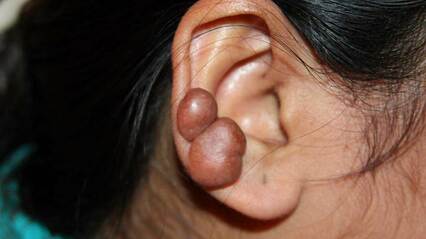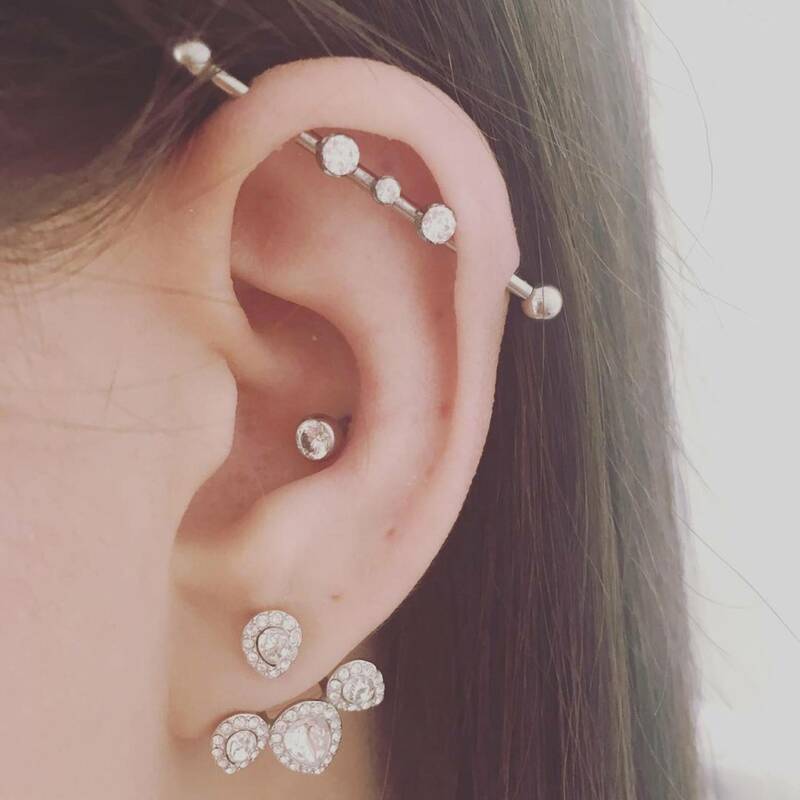 Keloids are a Sign to Avoid Piercing in the Future Keloids are a Sign to Avoid Piercing in the Future Body piercing has evolved as a fashion statement from the age-old concept of sexual desirability. It is the art of inserting a hole in the skin or body part to make provision for a piece of jewelry as a decorative ornament. In India, most girl babies and some boy babies have their ear lobes pierced as a part of their culture and no other body part is as dominantly pierced as this. Body piercing was initially considered an extreme art form but now has been accepted with ease among the general population. Individuals desire to get their body piercing in different places and numbers and every choice has a motivational factor behind it. Seen initially as a tradition related to increased sexual desirability and experience, it is now seen as a trademark, trendsetter or a non-suicidal form of self-injury. Done with a sharp needle, the process definitely carries with it an increased risk of blood-borne infection and other problems, unless extreme care and precaution is taken by the piercer. Done by professional piercers, individuals who face complications visit their piercer instead of going to their physician. These individuals feel that their doctors would be unmindful, ill-equipped or biased against them, especially when they have multiple piercings or piercing in intimate body parts. Common reasons that push individuals to meet their piercer include bleeding, infection, tissue trauma and scarring which is present in almost 50% of individuals who are pierced. Piercing can lead to metal allergy development and hence, the pierced individual should choose his/her ornamental jewelry with utmost caution. In today’s world, apart from earlobe piercing, common places to pierce include belly button, eyebrow, nose, tongue tip, nipples and genitals. Ear cartilage is also pierced by some people. Appropriate care of the piercing site becomes mandatory in certain circumstances-during pregnancy (genital piercing), lactation (nipple piercing) or surgery. Piercing Issues Infections at the Piercing Site: Any changes to the skin’s protective barrier paves way for skin infection due to staph or strep bacteria. Belly button piercing is the most commonly affected site during such piercing due to its shape. Antibiotics and skin hygiene are common treatment methods and there is no need to remove the jewelry. Blood-borne diseases: Piercing immediately reminds anyone of bloodstream infections such as hepatitis B or C or tetanus. This is very common due to unhygienic and contaminated piercing equipment. The person getting pierced should take extra precaution and get himself/herself vaccinated for hepatitis B, hepatitis C and tetanus beforehand. Dental illness: Tongue piercing can cause tooth fracture, chipped tooth, gum problems or enamel damage. The jewelry too is swallowed sometimes, when it is loosely fitted. Mouth or lip infections affect speech, food intake, swallowing and swelling problems that can block the throat. Jewelry problems: Nickel jewelry can cause problems but most of the inexpensive jewelry contain nickel. Adolescents are bound to buy such ornaments as they mostly lack funds and are forced to choose cheaper ones. Also, never accept jewelry which was already used by someone. Choose the right size, too big or too small can lead to a tissue scar or skin damage. Jewelry in the genitals can lead to breaking of condom and unplanned pregnancy or sexually transmitted diseases. Keloid Formation: Keloids are fibrous tissue overgrowth that can occur in people after a mild trauma to the skin and this is usually resolved with surgical excision, corticosteroid injections, radiation or laser dressing. Keloid formation is an indication to avoid piercing again. How Can the Piercer/Person Getting Pierced Take Precautionary Measures? The piercer must ensure to:
After-Care Once you are pierced, ensure to follow all precautionary measures as advised by your piercer. You would be asked to clean the pierced area with warm water and soap twice daily, use a liquid medicated cleanser while moving the piercing around and use an antibacterial mouth rinse when the tongue or lip is pierced. After following all the instructions, if you face any of the following problems, please get in touch with your physician immediately without any hesitation:
Comments are closed.
|
AVOID FRAUD. EAT SMART.+91 7846 800 800
AuthorDietitian & Nutritionist Dr. Nafeesa Imteyaz. Archives
July 2024
Categories
All
Dr. Nafeesa's Blog @blogspot |
- Home
- Written Testimonials
- Consult
- Clinics
- Blogs
-
Diet & Nutrition
- Diabetes Reversal
- IVF IUI not needed for PCOS PCOD Infertility
-
Medical Nutrition
>
-
Disease & Conditions
>
- Infertility | PCOS
- Diabetes Mellitus
- Cholesterol
- Hypothyroid
- Kidney Problems
- Hypertension
- Cardiovascular Diseases
- Liver Diseases
- Gastro intestinal disorder
- Cancer
- Metabolic Disorders
- Orthopedic Disorders
- Eating Disorders
- Dietary Recall
- Weight Record Filled By Clients
- Online Payment Transaction Details
- Online Clients Weight Check Form
- Our Program Package Service Charges
- Weight Record 2017 Clients
- Measurements sent by Clients
- Terms & Conditions Of Payment
- Thanks. Your Form is Submitted
- Video Testimonials
- Lifestyle & Wellness
- Lifestyle & Wellness Blog
- Allergy & Intolerance
- Weight Loss / Gain
- Weight Loss / Slimming Blog
-
Disease & Conditions
>
- Life Cycle Nutrition >
- Sports Nutrition >
- Integrity in Nutrition
- Knowledge Centre
© COPYRIGHT 2022. ALL RIGHTS RESERVED. FRST HEALTHCARE PVT LTD.
Dr. Nafeesa Imteyaz of First Eat Right clinic, is the Best Dietitian Nutritionist in Bangalore. Best Dietitian Nutritionist in Pune. Best Dietitian Nutritionist in Hyderabad. Best Dietitian Nutritionist in Chennai. Best Dietitian Nutritionist in Mumbai. Best Dietitian Nutritionist in Delhi. Best Dietitian Nutritionist in Kolkata.


